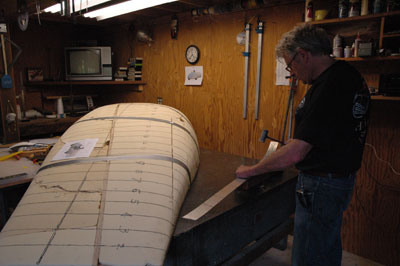 | The Search for Fuel Economy Pages from a Designers' Notebook Readers comments P3 |  | ||||||||||||||||||
| Chap. 8: Making the Middle Bulkhead The structure that will hold the streamlined body | ||||||||||||||||||||
 | ||||||||||||||||||||
| I am back home in Carmel, eager to resume work on this thing. It is time to come up with a name. Helix-Liner is your favorite but since Helix belongs to Honda, we must consider others. The next step is to make one half of the bulkhead behind me. This is pretty tricky since is is made up of compound curves. I have to hand pound a 2" strip of .100" aluminum and fit special, curved ends to it | ||||||||||||||||||||
| Pounding out the aluminum bulkhead | ||||||||||||||||||||
 | ||||||||||||||||||||
| Following the 2" duct tape band, I rivit together the pieces to make the left side band. This took over a day because I had to shape, rivit, reshape, make new templates with different arcs until I got it to fit perfectly. Not hard... just time consuming. | ||||||||||||||||||||
| Getting the bulkhead to fit perfectly | ||||||||||||||||||||
| Once I am confident that I have the right bulkhead shape, I grab a section of the body. This is easy... I just use a razor blade and cut quick arcs and piece them together where they will fit. A hot melt gun sticks them together. Notice the my flat work table. It is not a work table at all. It is a Starrett granite "Surface Table." Dead flat. I can tell where the centerline is this way. My first fairing in 1966 was crooked because I worked from the floor, which sagged under my weight. It was not dead flat. |  | |||||||||||||||||||
| Section of the body under the bulkhead | ||||||||||||||||||||
 | ||||||||||||||||||||
| To make the other side, I don't actually have to make the other side in foam. I just need a template that represents the other side. Here I have cut a piece of 3/16 ply by drawing its shape from the cardboard template I just made above. | ||||||||||||||||||||
| The shape as if I sliced thru the body with a knife | ||||||||||||||||||||
 | ||||||||||||||||||||
| It is simple to draw a line on 5/8" plywood, flip it over on the centerline and draw the other side. With a saber saw, I cut out the full section in the 5/8" plywood. Now I have a strong shape on which to make the other side. | ||||||||||||||||||||
| Transferring it to a strong plywood bulkhead | ||||||||||||||||||||
 | ||||||||||||||||||||
| Now I can duplicate the band in reverse for the right side and put all the pieces together to make the bulkhead band. The resulting band is a wierd shape. None of the sides are parallel because they all fall onto the fishy shape. This is about two days work. But, It is worth the time. | ||||||||||||||||||||
| This is the exact shape of the fishey shaped streamlined body | ||||||||||||||||||||
 | ||||||||||||||||||||
| It is time to remove the CAD (Cardboard Aided Design) and strip my trusty Helix of its plastic bodywork. The foamboard has served me well, having servived a thousand miles of riding. Only twice did I have to return home because of rain. Well, it is California. As far as I am concerned, the actual riding with this bodywork is the most important part of the design process. | ||||||||||||||||||||
| Time to strip the Helix down to its essentials | ||||||||||||||||||||
 | ||||||||||||||||||||
| I don't know about you but I was shocked at how little was left after I stripped the Helix of everything I did not want. | ||||||||||||||||||||
| Shocking | ||||||||||||||||||||
 | ||||||||||||||||||||
| The bulkhead fit right on. Nothing has to be cut off. Even the center stand works. Amazing. Time to make a strong crossbar to hold it in place. Aircraft "Cleco Clamps" are perfect for this kind of work. The tabs on the top are for the trick headrest that will be coming up in the next chapter. | ||||||||||||||||||||
| Fitting the bulkhead | ||||||||||||||||||||
 | ||||||||||||||||||||
| Hand pounding the seat structure from .100 x 2" aluminum strap. I won't be using the original seat because I want to be able to "Squirm around" so my butt doesn't hurt. I don't like "stepped seats". Mike Corbin's shop is just 40 miles away. Maybe Mike will make me a new, super cross country seat. | ||||||||||||||||||||
| Pounding out the new seat loop | ||||||||||||||||||||
 | ||||||||||||||||||||
| You can see how the structure is evolving. Unfortunately, most of what I do, I do two or 3 times before I get it right. My garbage can is full of mis-shapen streamliner parts. It is just part of the design process Looks simple, doesn't it? Simple and strong are what I think of as "Classic American Design" | ||||||||||||||||||||
| Classic American Design | ||||||||||||||||||||
 | ||||||||||||||||||||
| As of June 1, 2008 | ||||||||||||||||||||
| Conceptually, these are very different vehicles. The original Helix is designed to carry two people with a trunk for storage. It is a great machine. Its fairing does a pretty good job of protecting the occupants and it gets 64 mpg, riding it hard. I want to move one person cross-country at real posted speeds, into headwinds, over mountains, with the best wind penetration possible. I doubt that Honda had this in mind for their Helix. I am hoping that real streamlining will lead to dramatic reduction in fuel consumption. | ||||||||||||||||||||
| This page updated June 1, 2008 | ||||||||||||||||||||








